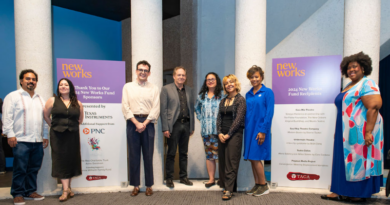Dallas County Three-Day New Case Total Reaches 750
As new cases of the novel coronavirus begin to climb, and the state begins to open more businesses, a lot of information can come at once. Here are today’s bullet points:
- Dallas County three-day new case total reaches 750
- Hinojosa to lead state effort to improve internet connectivity
- Allred: We can beat coronavirus but need to go on the offensive
- Dallas furloughs nearly 500
- Abbott seeks FEMA aid for food banks
Dallas County Three-Day New Case Total Reaches 750
A total of 750 new cases of the novel coronavirus have been reported by Dallas County health officials between Friday and Sunday, and an additional 18 deaths, bringing the county’s total cases up to 5,870, with 143 deaths.
If the numbers continue apace, it is likely that the city will reach 6,000 cases by today.
The county reported 249 new cases and 10 deaths on Friday, 250 new cases and eight deaths on Saturday, and 251 cases and no deaths on Sunday.
Deaths included a Garland man in his 30s who had been found dead in his home. Nine residents of area long-term care facilities ranging in age from a man in his 40s to a man in his 90s died, too. To date, more than a third of all COVID-19 deaths have originated at long-term care facilities.
Other deaths attributed to COVID-19 include two Dallas men in their 50s, a Cockrell Hill man in his 50s, a Lancaster woman in her 60s, a Dallas man in his 70s, a Balch Springs woman in her 70s, an Irving man in his 70s, and a Farmers Branch woman in her 80s.
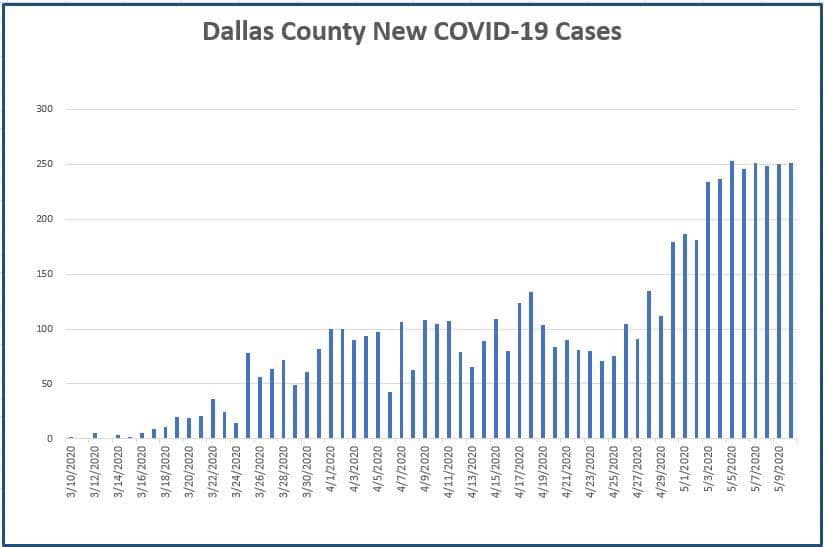
It is not known if the numbers will be lower in the next few days due to the Dallas Community Based Testing Sites at the American Airlines Center and Ellis Davis Field House being closed for Mother’s Day. Testing was due to resume Monday at 8 a.m.
In his evening newsletter, Dallas Mayor Eric Johnson said that 25 hospitals reported their bed availability Sunday. Of the 5,712 total beds, 61% are occupied – which is up slightly from the 58% we reported last Sunday. Of the 827 ICU beds available, 66% (or 547) are occupied, compared to 532 last weekend. And 318 of the total 947 ventilators available are currently in use.
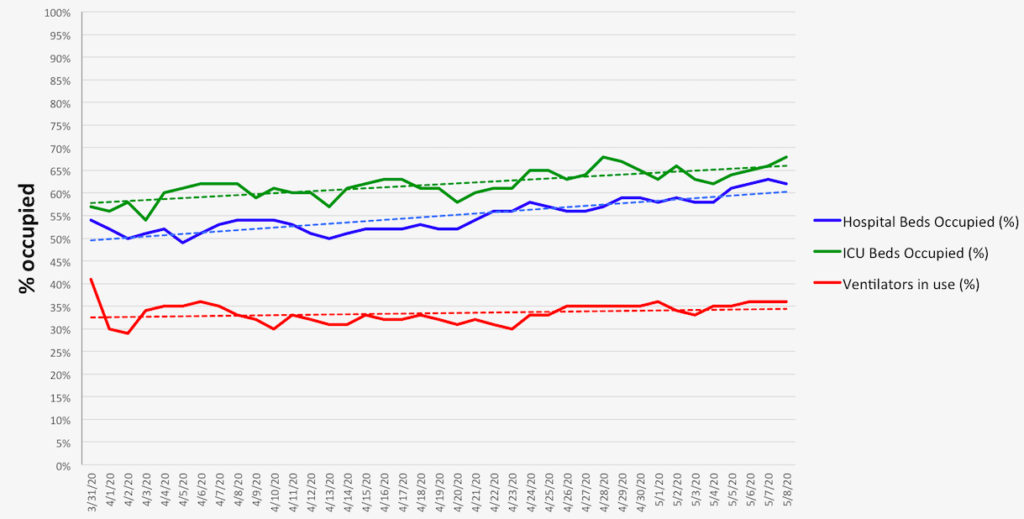
Of cases requiring hospitalization who reported employment, about 80% have been critical infrastructure workers including those in healthcare (18%), transportation (16%), food and agriculture – which includes grocery stores and places you can buy food (15%), public works (8%), finance (5%), communications (4%), teachers, real estate, and clergy (8%), and first responders (3%).
In the county’s May 8 aggregate report, most cases continue to be between the ages of 18 and 60, with the 18-40 age group accounting for 39% of the cases, and the 41-64 age group accounting for 42% of the total cases.
There were 2,474 men who were diagnosed with the novel coronavirus (or roughly 54%) and 2,098 women.
Close contact or community transmission continues to be the biggest risk factor for contracting COVID-19, accounting for roughly 82.5% of all cases. Living in a long-term care facility, being incarcerated in the county jail, and domestic travel are a distant second, third, and fourth, at 6%, 5.3%, and 2.3%, respectively.
Of the testing done, positive cases accounted for 9.4% as of May 2, with 295 positives coming from 3,134 tests. However, testing and positive test results of COVID-19 far outpaces any other respiratory virus – even if you combine them all.
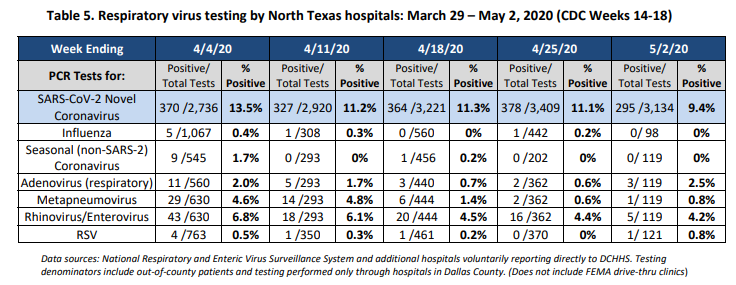
Hospitalizations because of COVID-19 have also eclipsed influenza hospitalizations, too, and have for some time.
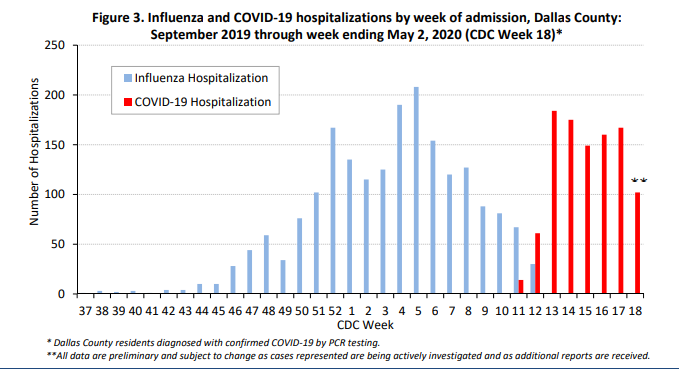
And COVID-19 symptoms have begun to outpace influenza-symptoms at emergency rooms, too.

Both Johnson and Jenkins have taken pains to point out that less than one percent of the county’s population is being tested for COVID-19.
Nineteen percent of all cases ended up hospitalized – 30% ended up in critical care, and 19% ended up on a ventilator.
In a city-by-city breakdown, Dallas still comes in with the highest number of cases – 2,989, or 55.7%. Highland Park has 18 cases so far, and University Park has 25.
The county does not count recoveries because it’s not a variable being used nationally by the Centers for Disease Control and Prevention, nor by state health departments. However, one can extrapolate that the 76% of total cases that have not been hospitalized – at the very least – are on their way to recovery or have recovered, county officials explained recently.
“The exact number of patients who have been released from area hospitals to continue their recovery at home is not available at this time,” Lauren Trimble, Dallas County Judge Clay Jenkins’ chief of staff, said.
Hinojosa To Lead State Effort To Improve Internet Connectivity
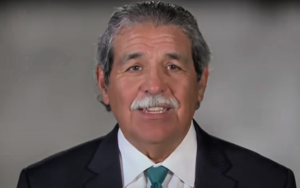 Dallas ISD Superintendent Michael Hinojosa mentioned it last week, but Friday Gov. Greg Abbott announced that the state was moving forward with an initiative to improve broadband internet service across the state – and that he had tasked Hinojosa with leading the charge.
Dallas ISD Superintendent Michael Hinojosa mentioned it last week, but Friday Gov. Greg Abbott announced that the state was moving forward with an initiative to improve broadband internet service across the state – and that he had tasked Hinojosa with leading the charge.
On May 5, Hinojosa said that the district would be working to improve access by working with state and local officials, as well as various organizations in a public-private partnership. Hot spots are working for now, he said, in helping his students who don’t have access to broadband service in their neighborhoods, but they aren’t a perfect solution.
That, he said, would be to permanently improve access across the city.
“Having broadband is not a luxury. It is a necessity,” he said.
Dallas ranks number six in the country – and number one in Texas – of urban cities with families without fixed Internet access. The pandemic has shown just how vital access to broadband internet is, Hinojosa said, because it’s powering job applications, unemployment assistance, seeing a doctor through telemedicine, and even getting news.
“We will relentlessly pursue this until we have an answer,” Hinojosa said. “Internet connectivity should join water, electricity, gas, and wastewater as an essential service.”
Abbott and Texas Education Agency Commissioner Mike Morath launched Operation Connectivity Friday, using the efforts by Dallas ISD as a jumping-off point for a statewide effort to improve access.
“As Texas students continue their education at home through virtual instruction, it is essential that we provide them with the resources they need to connect and communicate online,” said Abbott. “I applaud Dr. Hinojosa and DISD for developing this innovative initiative for Dallas schools, and look forward to expanding Operation Connectivity statewide so that we can implement reliable and effective solutions that will close the digital divide for students across the Lone Star State.”
“We are grateful for the work of Dr. Hinojosa and his leadership on this necessary undertaking in Dallas and are delighted to be working with the Governor to take this effort statewide,” said Morath. “With students learning remotely for the time being, it’s more important than ever for all our students to be able to access academic content at home.
“In order for that to happen, all students in Texas need access to computers and/or tablets, and internet outside of the classroom. Operation Connectivity is providing the right solutions to this big challenge.”
Hinojosa will lead the task force as Morath’s co-chair, and state Sen. Larry Taylor and state Rep. Dan Huberty will serve as members as well.
The task force members will also include representatives from the governor’s office, other local education agencies, the U.S. Department of Education, the Federal Communications Commission, EducationSuperHighway, the Federal Reserve Bank of Dallas, the Department of Information Resources, the Texas Computer Education Association, and the Chief Technology Officer Council of Texas.
The task force will assess the gaps in connectivity across the state, look at best practices, and then identify and secure solutions, as well as develop a “playbook” for other districts. They will also identify funding needs and resources, and push for new policies on the state and federal level to improve broadband service and access to technology.
Allred: We Can Beat Coronavirus But Need to Go On the Offensive
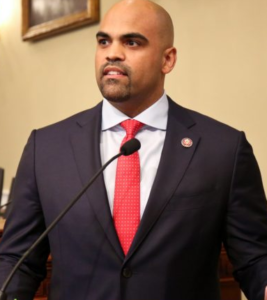 U.S. Rep. Colin Allred had a conversation with Matt Goodman at our sister publication, D Magazine, about what it’s going to take to truly move past the pandemic.
U.S. Rep. Colin Allred had a conversation with Matt Goodman at our sister publication, D Magazine, about what it’s going to take to truly move past the pandemic.
In short, we’re not doing what it will take to truly move past the pandemic.
“What we’re seeing now, I think, is the natural outcome from a lack of honest discussion with the American people not only about what we’re facing but how long we’re going to be facing it and about how serious it is,” Allred said.
See more about what he says it will take here.
Dallas Furloughs Nearly 500
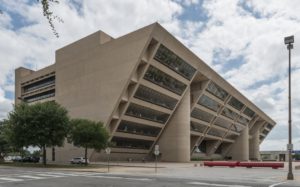 As we reported in last Thursday’s digest, city of Dallas staff projected a $25 million drop in sales tax revenue – with a total revenue drop of $33 million for the year. Franchise taxes and service charges are also taking a hit.
As we reported in last Thursday’s digest, city of Dallas staff projected a $25 million drop in sales tax revenue – with a total revenue drop of $33 million for the year. Franchise taxes and service charges are also taking a hit.
Now the city is beginning to see how that shortfall will manifest itself after a Friday letter from City Manager T.C. Broadnax revealed that Dallas will furlough 472 city employees this week until the end of July.
The Park and Recreation department and library department will see hundreds furloughed, with about 235 from the 900 full-time parks department staff impacted, and about 187 out of 400 library employees. The city’s Office of Arts and Culture will also see furloughs.
“The city manager notified the City Council of his decision on the furloughs this morning,” Dallas Mayor Eric Johnson said Friday. “Although I knew such measures were likely, my heart continues to break at the news of more economic pain for people in our city. Further difficulties may still be ahead as we face historic budget shortfalls caused by COVID-19.
“But I want to assure city of Dallas employees and the people of Dallas that I will continue to advocate for equity and fairness as we seek federal assistance and work to reduce our expenses while maintaining as many key services as possible.”
Abbott Seeks FEMA Aid for Food Banks
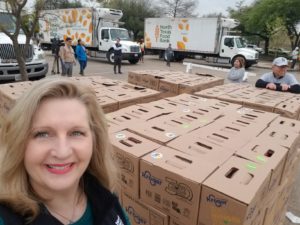
Gov. Greg Abbott said Friday that the Texas Division of Emergency Management has requested Federal Emergency Management Agency assistance to help support state food banks during the increased demand during the pandemic.
If approved, this funding will provide nearly $70 million for Texas’ network of 21 food banks and will allow food banks to work with their supply chain networks to shore up supplies and provide more nutritional support to those in need.
“This funding is crucial to helping ensure our network of food banks can continue to provide food to Texans in need,” said Abbott. “Our food banks have tirelessly served their fellow Texans throughout the COVID-19 response, and this pandemic has led to a quick depletion of supplies and resources for these organizations.”
The State of Texas is committed to giving these organizations supplemental support during these challenging times so they can continue providing resources to those in need,” he added. “I thank TDEM for working closely with FEMA to apply for these funds, and remain grateful to the staff and volunteers of our food banks here in the Lone Star State. These selfless and hardworking Texans represent the very best of our great state.”









